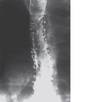Diseases of the Esophagus Flashcards
Acts as a conduit for the transport of food
Esophagus
How long is the esophagus in cm?
18-26 cm long hollow muscular tube
In order for the esophagus to accommodate food it distends by how much?
To accommodate food:
o lumen distends up to 2 cm AP and 3 cm laterally
What are the four layers of the esophagus?
esophageal wall: 4 layers
o innermost mucosa
o submucosa
o muscularis propria
o outermost adventitia
o NO SEROSA
Where does the esphagus begins?
Origin: neck at the level of the cricoid cartilage
Where does the esophagus ends?
Ends after passage through the hiatus in the right crus of the diaphragm by joining the stomach below
Esophageal diseases can be manifested
by i________________.
mpaired function or pain
What are the key functional impairments of the esophagus?
Key functional impairments are
swallowing disorders and excessive gastroesophageal reflux.
The remains central to the evaluation of esophageal
symptoms.
clinical history
A thoughtfully obtained history will often expedite management.
Important details include
- weight gain or loss,
- gastrointestinalbleeding,
- dietary habits including the timing of meals,
- smoking,
- and alcohol consumption.
The major esophageal symptoms are
- heartburn
- regurgitation,
- chest pain
- dysphagia,
- odynophagia, and
- globus sensation.
__________
o Most common symptom
o Discomfort or burning sensation behind the sternum
o intermittent symptom most commonly experienced after eating, during exercise, and while lying recumbent
o relieved with drinking water or antacid
o but can occur frequently
HEARTBURN
_____________
o Effortless return of food or fluid into the pharynx without nausea and retching
o Patients report a sour or burning fluid in the throat or mouth that may also contain undigested food particles.
o Bending, belching, or maneuvers that increase intraabdominal pressure can provoke regurgitation
REGURGITATION
________
Preceded by nausea and retching
VOMITING
___________
Is a behavior in which recently swallowed food is regurgitated and then swallowed repetitively for up to 1 hour
RUMINATION
_______
o Pressure type sensation in the mid chest radiating to the mid back, arms and jaw (Esophageal Pain)
o common esophageal symptom with characteristics similar to cardiac pain, sometimes making this distinction difficult.
CHEST PAIN
What is the most common cause of chest pain in esophageal dse?
Gastroesophageal reflux is the most common cause of esophageal chest pain
**The similarity to cardiac pain in chest pain brought about by esophageal symptoms is likely because_______________________
the two organs share amnerve plexus and the nerve endings in the esophageal wall have poor discriminative ability among stimuli
_________
o Food sticking or lodging in the chest
o Solid and liquid food VS solid food only
DYSPHAGIA
How to distinguised dysphagia?
o Important distinctions are between uniquely solid food dysphagia as opposed to liquid and solid, episodic versus constant dysphagia, and progressive versus static dysphagia.
If the dysphagia is for liquids as well as solid food, it suggests a__________________.
**
motility disorder such as achalasia
Conversely, uniquely solid food dysphagia is suggestive ________________
of a stricture,
ring, or tumor
___________________
o Pain by swallowing (pill)
o pain either caused by or exacerbated by swallowing.
o more common with pill or infectious esophagitis than with reflux esophagitis
ODYNOPHAGIA
o When odynophagia does occur in GERD
it is likely related to an ___________________
esophageal ulcer or deep erosion.
______________
o Perception of lump or fullness in the throat irrespective of swallowing (anxiety)
o often relieved by the act of swallowing
o As implied by its alternative name (globus hystericus), globus sensation often occurs in the setting of anxiety or obsessive-compulsive disorders
GLOBUS SENSATION / GLOBUS HYSTERICUS










